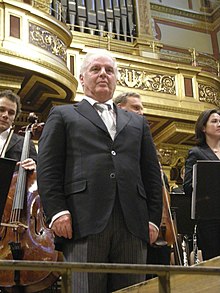Black lounge suit
| Part of a series on |
| Western dress codes and corresponding attires |
|---|
|
Legend:
Contents/Culture and the arts portal |
The black lounge suit (
Wearing a black lounge suit the traditional way with formal trousers largely fell out of use following the counterculture of the 1960s, although its practice has still been observed occasionally ever since.
For semi-formal
Name
In
In American English the style is referred to as a stroller suit, club coat or sack coat.[2]
Around
It is also known as a director's suit from the term inside director (especially in Japan), or citydress.
History


While early prototypes of black lounge suits did occur in the late 19th century, the current form was settled around 1900.[3]
Stresemann famously wore the suit during the negotiations of the Locarno Treaties in 1925, and in Germany it became synonymous with him.
In the United Kingdom this mode of dress is now unusual, though the dress code sometimes does occur in
The stroller's apparent decline in use, as opposed to the staying power of its evening counterpart the dinner jacket, could be attributed to several factors: daytime formality in general, and specifically the standard of changing clothes for various occasions, fell out of general use in post-
Traditionally, in Continental Europe and the British Commonwealth of Nations, morning dress is worn to formal day events, and white tie for formal evening events. However, when both dress codes declined in use in the United States, this also affected the use of the stroller.
Yet, notably, at his
In media
Gentlemen's
Gallery
-
Caricature ofVanity Fair(20 November 1880)
-
(1915)
-
Gustav Stresemann (sitting on the right, with Augustinas Voldemaras), Berlin (1928)
-
Further detail
-
U.S. President Ronald Reagan and wife Nancy Reagan waving from the limousine during the inaugural parade in Washington, D.C.(1981)
-
President Kennedy wears a black lounge to a diplomatic reception at the White House in 1961
-
President Carter, Vice President Mondale and President elect Reagan in stroller suits before Reagan's Inauguration in January 1981.
-
Eleven years oldPrince Albert Victorin black lounge suit.
See also
References
- ^ Book of Etiquette (1931), Lady Troubridge
- ^ "Where Have All the Haberdashers Gone?". Chicago Tribune.
- ^ Duka, John (2 January 1981). "Inauguration Day '81: A Sartorial Controversy". The New York Times.
- ^ Duka, John (2 January 1981). "Inauguration Day '81: A Sartorial Controversy". The New York Times.
External links
 Media related to Stresemann at Wikimedia Commons
Media related to Stresemann at Wikimedia Commons










